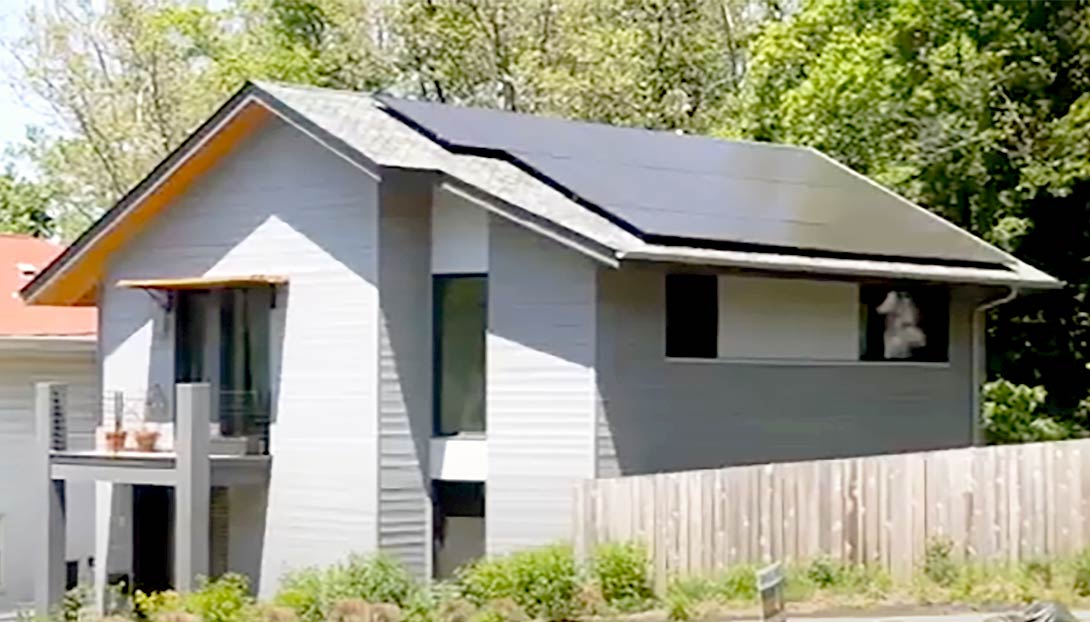Couple's 'Passive' House Shows What's Possible In The Fight Against Climate Change
Westchester Wife and Husband Have Created the Ultimate Green Home
Christina Griffin got her architectural education in the 1970s when international tumult was causing energy prices to rise, creating urgency among Americans to find ways to conserve.
Decades later, she and her husband, environmental lawyer Peter Wolf, have responded to the harsh reality of climate change by combining their expertise to build a comfortable home with minimal energy costs.
“Throughout my career, I’ve focused on design that reduces energy usage,” Griffin said. “With climate change, that’s more urgent than ever and fortunately we have building science that allows us to get to net zero energy usage.”
“We are committed to leaving this earth a better place than we found it,” said Wolf, who was chair of the village’s Conservation Commission for 10 years. “Climate change is an existential threat and worse than many people realize. I think we need a unity of spirit and all contribute to sustaining our planet.”
The couple bought the home, a drafty, energy inefficient fixer upper built in 1905, in 2019. They turned it into what is called a passive house. (See a video on the couple’s house.)

Passive House Principles
Passive House principles emphasize energy efficiency and clean energy technologies so that the house uses little energy. Passive houses have thick insulation that wraps under the floors, up and down the walls and along the roof. The insulation forms a continuous thermal envelope.
Passive houses take advantage of the sun’s rays for lighting and heating. They are airtight, with ultra-energy efficient windows. All passive houses do not have solar panels, but the home Griffin and Wolf created have 28 panels facing southeast with the capacity to produce 10.8 kilowatts of clean, renewable power.
Those panels provide enough power to run the home, charge batteries and send some electricity back into the Con Edison grid for other customers to use. The company, which handled the interconnection for the panels, provides credits to Griffin and Wolf for the power that goes back into the grid.
The panels also power Wolf’s home office behind the house and will produce enough electricity to power the electric cars Griffin and Wolf plan to buy.
The trellis that extends off the roof on the side with the solar panels demonstrates how every component of the house’s design emphasizes environmental sustainability.
The trellis blocks the light from the high sun from hitting the house during the summer. That lowers the home’s air conditioning needs. But the size and position of the trellis lets the rays from the winter’s lower sun hit the house during the winter, lowering the need for heating.
The house, which has two bathrooms and three bedrooms, has a small air-source heat pump for heating and cooling. An air-source heat pump moves heat from inside a building to the outside like an air conditioner during the summer. In winter, it pulls heat from outside to bring it into a building.
The house has an energy recovery ventilation system that recovers warm air from return air ducts to help heat the house. It also provides at least one air exchange per hour, with vents in every room, creating a healthy indoor air climate.
The windows are triple-paned insulated glass with large panes facing south to capture passive solar heat. Even the frames have insulation to reduce heat loss and drafts.
The couple spent $800,000 on the renovation, increasing the size from 950 to 1,700 square feet. But they pay no monthly energy bill, other than the connection charge to Con Edison.
Developing the Concept
Swedish engineer Bo Adamson and German physicist Wolfgang Feist began developing the passive house concept in the late 1980s.
Griffin and Wolf believe so strongly in Passive House principles that they co-founded the nonprofit Center for Sustainable Development to raise the level of sustainability in buildings.
To promote Passive House and Zero Energy principles, Griffin conducts seminars and hours of the house, reaching out to homeowners, contractors and other architects.
The couple even opened the home to scheduled visits one weekend this spring, so that others could learn.
Griffin’s firm, which carries her name, designed the townhouses that received the first Platinum LEED for Homes certification in Westchester in 2010. Energy efficiency is a key part of Con Edison’s Clean Energy Commitment. The company offers incentives for energy efficiency upgrades in homes, multi-family properties, small businesses and larger commercial and industrial buildings.
The company’s programs include incentives for geothermal and air-source heat pumps.
Con Edison also encourages customers to consider whether solar energy is right for them. The company has helped customers connect 57,000 solar arrays that have the capacity to produce 517 megawatts of power. (A megawatt is 1 million watts.)
Con Edison is a subsidiary of Consolidated Edison, Inc. [NYSE: ED], one of the nation’s largest investor-owned energy companies, with approximately $16 billion in annual revenues and $63 billion in assets. The utility delivers electricity, natural gas and steam, and serves 3.6 million customers in New York City and Westchester County. For financial, operations and customer service information, visit conEd.com. For energy efficiency information, visit coned.com/energyefficiency. Also, visit us on Twitter and Facebook.

